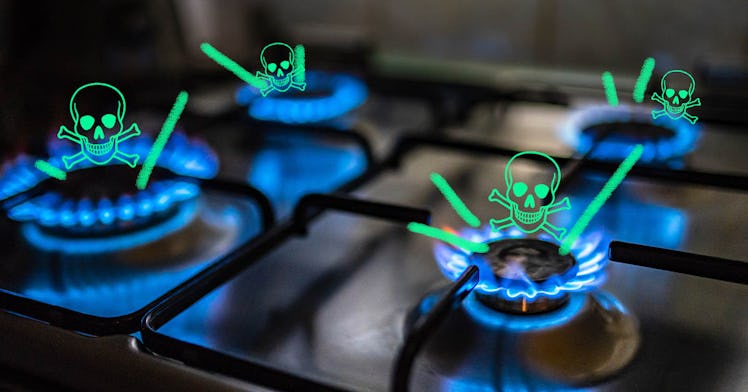Gas Stoves Are Hurting Kids, Public Health Experts Say
What parents need to know about the push to get rid of gas stoves.

Cooking on a natural gas stove can be dangerous to both the environment and families’ health, according to a new report from NPR. Firing up a natural gas stove releases nitrogen dioxide, and in indoors, levels of this pollutant can quickly rack up. Recently, public health experts have been warning about the health risks these appliances, especially for kids. Not only can they exacerbate existing respiratory issues, but they may even cause asthma in some children.
Here’s what parents should know about indoor air pollution, health risks, and efforts to change the way we cook at home.
What comes out of gas stoves?
Gas stoves run on natural gas, a mixture of hydrocarbons such as methane. Cooking with one is easy; they usually light automatically and burn gas without any smoke or soot. But just as with burning any fossil fuel, cooking with gas releases compounds we can’t see. Some of these unseen pollutants, such as nitrogen dioxide, can harm our health, especially in the closed-off environment of a house.
Nitrogen dioxide is present all around us, according to the Environmental Protection Agency, produced by burning fuel for everything from vehicles to power plants. In response, the government sets standards for how much is allowed in the air through the Clean Air Act. But cooking on gas burners can force indoor nitrogen dioxide levels up above EPA standards for outdoor air, according to a 2017 study. There are currently no standards for indoor nitrogen dioxide pollution.
Gas stoves can also release other potentially harmful materials, such as benzene and small particulate matter, according to a recent review paper in the Journal of Environmental Health. In addition, burning natural gas releases greenhouse gases such as carbon dioxide, which contribute to the climate crisis.
What are the health risks of gas stoves?
As with most air pollution, the emissions from burning natural gas bring potential risks to our health. Nitrogen dioxide can be caustic to people with respiratory issues at high doses, and long-term exposure at low levels might lead to problems like asthma.
The risks to children specifically are especially high. Nitrogen dioxide is linked to symptoms such as coughing and wheezing in kids with asthma, according to the Journal of Environmental Health study. In addition, kids who live in homes with gas stoves may be more likely to have breathing issues, reports NPR, citing a 1992 analysis. NPR also points to a recent report on the health effects of gas stoves in the home from the Rocky Mountain Institute (RMI) and other groups, which specifies that children are more at risk from indoor air pollution due to their more fragile immune systems and more active lifestyles.
But nitrogen dioxide isn’t the only risky indoor air pollutant. Cooking, even on an electric stove, can release tiny particles into the air such as PM2.5 (particles smaller than 2.5 micrometers, about one third the size of a red blood cell), according to the RMI report. The EPA notes that this sort of particulate pollution is also linked to respiratory issues, in addition to some cardiovascular problems. Burning natural gas, although cleaner than a wood-burning stove, may up the ante on air quality concerns.
What can parents do about it?
Families who have a gas stove at home, or are worried about indoor air quality in general, do have options. For one, use the kitchen ventilator if you have one. The RMI study suggests keeping the fan going while cooking or opening the window if that’s not an option. This can sometimes make a big difference: The same study which found that cooking can push nitrogen dioxide levels above standards for outside air also found that using the exhaust fan notably reduced pollution in some homes.
The RMI report also suggests swapping your gas stove for an electric one. But this can be expensive, as new electric stoves can cost hundreds of dollars or more. Some people are pushing the government to take action to electrify our home appliances, from both a health standpoint as well as an environmental one, NPR reports.
But the natural gas industry isn’t too keen on this idea, according to Vox. Industry groups and people associated with natural gas have been vocal opponents of electrification measures. In addition, Vox notes, the industry has promoted natural gas with, for example, cooking videos. Last year, Mother Jones reported how this campaign is spreading to Instagram influencers with the hashtag #CookingWithGas.
Some officials are taking action. A couple cities in California have tried to encourage electric appliances in buildings, Vox reports. In addition, at least one version of the budget reconciliation bill working its way through Congress would create rebates for replacing non-electric stoves with electric ones. Bas lawmakers continue to debate the bill, the future of such provisions is unclear.